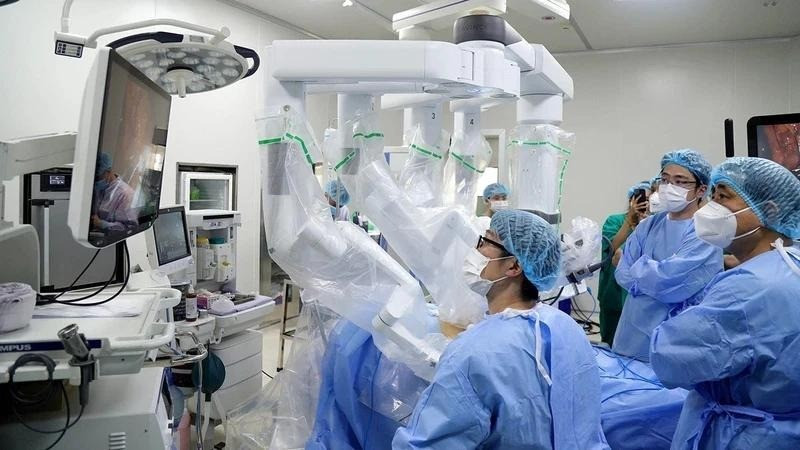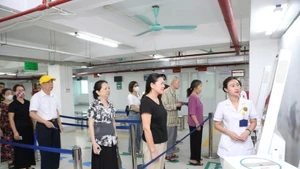In recent years, the health sector has made great efforts to protect, care for, and improve public health.
To date, the network of healthcare facilities in our country has been widely developed from the central to grassroots levels, gradually meeting the healthcare needs of people in all regions, from basic to specialised care. The healthcare workforce has also been increasingly strengthened in both quantity and quality, with nearly 500,000 people, including many medical experts with world-class expertise who are capable of performing advanced medical techniques comparable to those in developed countries.
The capacity to provide medical examination and treatment services has continuously improved in terms of quantity, quality, coverage, and level of specialisation. The total number of medical examinations and treatment visits covered by health insurance increased by an average of 5% per year during 2015–2024, reaching 186.2 million visits in 2024.
The quality of medical examination and treatment services has also improved, with Viet Nam having mastered cutting-edge techniques in the medical field (such as multi-organ transplants on a single patient, fetal cardiac intervention...). Many advanced techniques have been transferred from central hospitals to satellite and local hospitals nationwide.
With efforts from the entire health system, Viet Nam's health indicators have significantly improved. In 2024, the average life expectancy of the population was 74.7 years, meeting and exceeding the target set by Resolution 20 of 74.5 years, and higher than the global average (73.3). Viet Nam has been recognised internationally as a bright spot in achieving the Millennium Development Goals in the field of health. The physical health of Vietnamese people has markedly improved, including height and the nutritional status of children.
The assessment results for universal health coverage in Viet Nam in 2023 reached 68 out of 100 points, higher than the Southeast Asia regional average (62 points). Viet Nam’s Human Development Index (HDI) has steadily improved over the years, and since 2019, the country has been ranked among those with high human development and has maintained that status to date.
According to the 2024 Human Development Report by UNDP, Viet Nam's HDI reached 0.726, ranking 107th out of 193 countries and territories. Among the three component indices, achievements in health ranked highest.
Notably, the trend of improving Viet Nam’s basic health indicators has been assessed as relatively sustainable, even during the period heavily affected by the COVID-19 pandemic. Public access to and benefit from health services have increased. Data from hospitals show that in 2024, the outpatient satisfaction rate was 96.14%, and the inpatient satisfaction rate was 95.14%. According to an independent survey by the Health Strategy and Policy Institute, the satisfaction rate increased from 85.3% in 2016 to 85.8% in 2020 and reached 90.5% in 2024.
Currently, Viet Nam is entering a new era of development. For the health sector, the key issue is determining its role and contributions in this new development era. At a working session with the Ministry of Health marking the 70th anniversary of Vietnamese Doctors' Day (February 27), General Secretary To Lam emphasised that, alongside achievements, the health sector is facing major challenges that require significant reforms to ensure the goal of universal health care in the new context.
These challenges come not only from internal factors within the sector but also from economic, social, and technological factors. One of the biggest challenges for the health sector is to fulfil its mission of caring for the health of the people and the community, creating a well-qualified workforce for society, and ensuring a healthy, happy life for everyone. Everyone should receive healthcare to achieve the desire for longer life expectancy and good health, and a healthy society free from epidemics and dangers.
To address the challenges facing the health sector now and in the years to come, in addition to effectively continuing to implement the Party's resolutions on health, General Secretary To Lam highlighted twelve areas, from reforming thinking in the health field and enhancing medical ethics among health workers to consolidating and improving the quality of the grassroots health system and completing health legislation.
According to Associate Professor, Dr Phan Le Thu Hang, Deputy Director of the Planning and Finance Department under the Ministry of Health, to develop effectively and sustainably in the future amid intertwined opportunities and challenges, the health system must identify and make good use of opportunities while effectively addressing the external and internal challenges it faces.
In the new development phase, the health system must fulfil all three roles simultaneously: being a solid pillar of social security, ensuring health security, and functioning as a special service sector that contributes to economic growth. Firstly, the health system must be developed in proportion to the overall socio-economic development of the country, to become a developing country with modern industry and upper-middle income by 2030, and a developed, high-income country by 2045.
Secondly, the health system must make a positive and effective contribution to the socio-economic development process. This contribution can be demonstrated in various aspects, such as healthcare ensuring a healthy workforce and contributing to improved overall labour productivity; healthcare as an economic sector attracting a large number of workers, mainly high-quality labour; healthcare as a service sector with large revenue potential and the ability to contribute directly to economic growth.
Thirdly, the health system must ensure the distribution of the benefits of socio-economic development to the people, allowing the public to enjoy the fruits of economic growth through quality healthcare services that are essential, basic social services providing direct and tangible benefits.
















